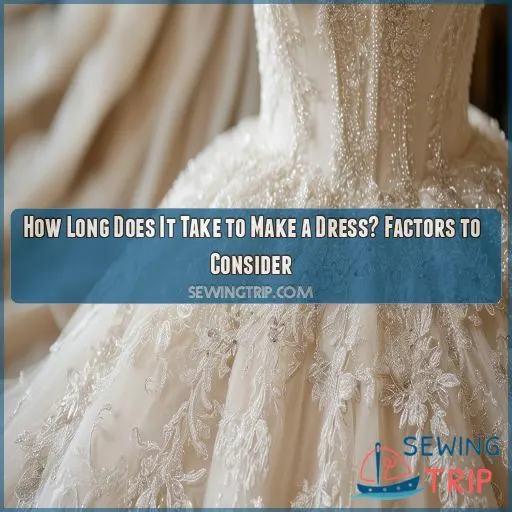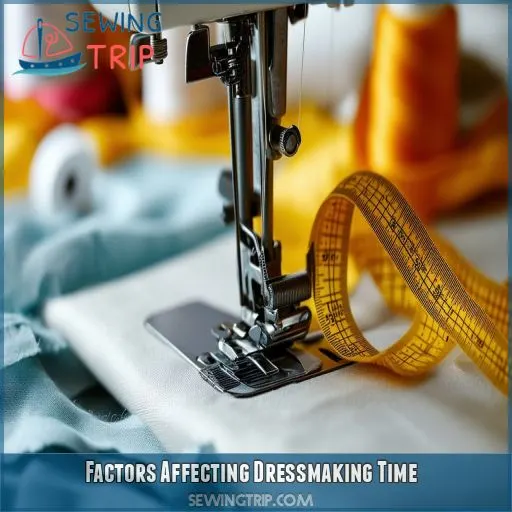This site is supported by our readers. We may earn a commission, at no cost to you, if you purchase through links.
 Imagine a world where each single stitch is narrating a story, just like on a well-tailored dress.
Imagine a world where each single stitch is narrating a story, just like on a well-tailored dress.
You must be wondering how long it takes to make a dress.
Again, the answer isn’t as simple. It depends upon various factors: the intricacy of the design, the number of layers it involves, and the nature of beading or embroidery that will be done.
We will go over these elements so that you get an idea of what goes into the making of that perfect dress.
Table Of Contents
Key Takeaways
- Crafting a dress is like sculpting a masterpiece, requiring precision, patience, and passion.
- The time it takes to make a dress can vary greatly depending on factors such as design complexity, skill level, and whether you use specialized tools.
- Fittings and alterations play a crucial role in ensuring a perfect fit and elevating the gown from a simple garment to a bespoke masterpiece.
- Timekeeping and using a stopwatch can significantly enhance your sewing productivity by helping you stay focused and manage your time effectively.
How Long Does It Take to Make a Dress?
Creating a dress takes time, and how long it takes really depends on the details. If you’ve got a simple sheath dress in mind, you’re looking at around 40-60 hours of work.
But if you want something more intricate like a beaded wedding gown, you could be talking 80+ hours! It all comes down to the complexity of the design, the number of layers, and the intricacy of any embroidery or beadwork.
The dressmaker’s skill level and experience also play a big role. So be prepared to invest some serious time and effort – but trust me, the end result will be worth it.
Want to dive deeper into what goes into making a dress?
Factors Affecting Dressmaking Time
When you’re considering the time required to make a dress, the design’s complexity and the number of layers play significant roles. Additionally, the intricacy of any beading or embroidery can greatly affect the overall time needed.
Complexity of Design
Design complexity highly impacts dressmaking time. Factors include:
- Beading and Embroidery: Intricate patterns consume much time.
- Choices of Silhouette: Slim silhouette requires more accuracy.
- Complexity of the Materials: The specialization of fabrics may make lay & cut procedures more complicated.
These elements are very demanding and need careful attention, thus lengthening the sewing time and finishing touches.
Number of Layers
The construction time taken for a dress goes by layers. Layers add complexity to the fit and flash of a dress or outfit.
More layers usually mean intricate work with lining and interfacing joins, topped off with embellishments. A lot of that goes into any wedding dress made especially for one bride.
Each layer calls for special attention, extending the wedding dress timeline along with checkpoints for fittings to ensure your design stays flawless.
Intricacy of Beading or Embroidery
As far as the number of layers is concerned, then the complexity of beading or embroidery does matter.
- Intricate beading: Means that every single bead has to be meticulously placed.
- Heavy beading: Adds hours due to heavy beading.
- Detailed embroidery: Involves precision and time.
- Lace overlay with embroidery: Requires more technique.
- Wedding gowns: Involve extensive embroidery work.
All these factors increase many times over the time it takes to do dressmaking.
Labor Costs and Time Considerations
The hourly wage that’s paid to the dressmaker and the number of hours that need to be completed are the two most influential factors on a dress project’s labour cost. Furthermore, skill levels and experience of the dressmaker can have a massive influence on how many hours it takes to make a dress.
Hourly Wage of Dressmaker
The skill level of the dressmaker hourly wage differs greatly between her and geographically, which impacts your final cost tremendously. Keeping an accurate record of time spent measuring, marking the fabric, or working on a serger is paramount. Good project management makes life easier; therefore, time to create a dress is within your budget and fulfills all your expectations.
Number of Hours Required
The number of hours required to make a dress varies widely. For simplicity, consider these general guidelines:
- Smooth/Standard gowns: 40-60 hours
- Latin/Rhythm dresses: 60-80 hours
- Wedding dresses: More than 80 hours
- Additional time for fittings, alterations, and shipping
These numbers depend on dress patterns, neckline design, and the geographic location of the dressmaker.
Experience and Skill Level
This experience and skill of a dressmaker are drastically different in both labor cost and time.
Apprenticeships, industry certifications, and training workshops can all facilitate the development of essential skills.
Mentorship allows novices to be taught by experienced individuals.
An individual can perfect their craft in dressmaking with dedication and practice.
High quality in garments can only be delivered if the timestep involved is correct.
Only then will the investment in the development of skills show in the wedding dress projects.
Materials Impacting Time Frame
Choosing appropriate fabric, lace, and trims is important, for it may include some heavy materials that could drastically vary the time of making a dress. Other notions like threads also affect the time frame, hence picking these notions carefully is important in considering the time for dressmaking.
Fabric Selection
Choices of fabric can directly influence how long a project is going to take. Apparel dresses require light, flowy materials, while structured fabrics would better suit sharp draping in, say, a prom dress.
Choosing the right material, therefore, becomes very important and may create much frustration if you end up working at very different speeds, especially during the installation of zippers, because each one requires special handling techniques.
Always go for fabrics that would be suitable for your dress style or level of complexity.
Lace and Embellishments
Lace and embellishments play a significant role in dressmaking. Hand-sewn lace, with its intricate details, can add hours to your project. Lace quality and lace complexity impact both the lace cost and the lace time needed. Delicate lace demands precision and patience. Embellishments, such as beads or sequins, require time and careful attention, adding to the overall timeline.
Notions and Thread
Choosing the right notions and thread is what can make or break your dress project.
High-quality threads will ensure strength, while their corresponding price will hurt your pocket.
The availability of notions and their varieties—like zippers and buttons—makes all the difference in functionality to achieve that overall look.
Always opt for thread quality and notion selection fusing easily to come up with a dress great-looking on any occasion and able to stand the test of time.
Design Complexity and Time Investment
In these regards, silhouette and style of the dress present as the major factors. The greater the complexity of the silhouette and the more intricate the style is, the more hours will be added to finish the dress, increasing its time value and cost.
Silhouette Choices
Choosing the right silhouette style impacts dressmaking time. Your body type, personal preference, and fashion trends all influence this decision. An intricate A-line or a fitted mermaid silhouette requires more precision and adjustments, extending the time needed. Also, consider the occasion; formal events might demand more elaborate designs, adding hours to your project.
Style of the Dress
The time the dress will take to make varies by the style. These are things like skirt length, sleeve style, neck line shape, amount of hem detail, and how the fabric drapes combine to give a general overall level of complexity.
The time taken to create a simple sheath dress with very little decoration will substantially vary from that for a highly elaborate ball gown with a cascading skirt and delicate lace details though giving a clear insight into design elements is important in planning time.
Frequently Asked Questions (FAQs)
How quickly can a dress be made?
You can make a dress in 40 to 80 hours depending on the style and complexity. Smooth gowns are quicker, while Latin/Rhythm dresses take longer due to intricate details and embellishments. Timing varies with skill level and design.
How long does it take to make a custom made dress?
A tailor-made dress could take between 6-17 days to complete, depending on the design complexity and fittings involved, as well as on the availability of the dressmaker. In tailoring, there are many intricate steps involved; therefore, proper communication at all stages ensures that the end product is delivered on time (Source).
Is it hard to make a dress?
Making a dress is like crafting a sculpture—it requires precision, patience, and passion. It’s not inherently difficult, but you’ll need to master sewing techniques, understand fabrics, and pay attention to detail.
Is dress making difficult?
Dressmaking can be challenging, but with the right techniques and patience, you can create stunning garments. The time required varies based on factors like design complexity, your skill level, and whether you use specialized tools like a serger.
What roles do fittings and alterations play?
Fittings and alterations, which can use up to 20-30% of the dressmaking time, are essential for getting a perfect fit, ironing out odd design adjustments, and really elevating the gown from simple garment to bespoke masterpiece.
How does shipping time affect dressmaking duration?
Shipping time can significantly impact dressmaking duration. Longer transit periods may require extra fittings and alterations, adding hours or even days to the overall project timeline. (Source)
How does timekeeping enhance sewing projects?
Timekeeping boosts your sewing projects by helping you measure actual time spent, stay focused, and manage your productivity better. It allows you to estimate future projects more accurately and make informed decisions on where to invest time.
What impact does using a stopwatch have?
Using a stopwatch boosts productivity by helping you stay focused and aware of how you spend your time. It acts as a gentle reminder, ensuring you remain engaged and efficient throughout your sewing projects.
Can a serger significantly reduce sewing time?
Such a serger can reduce your sewing time drastically. It literally trims your seam finishes as it cuts the fabric all in one step. You’ll feel like you have an extra pair of very efficient hands working with you, making your sewing faster and more professional.
Conclusion
Ultimately, the time it takes to create a dress is a symphony of intricate details, each stitch weaving a unique narrative.
From the complexity of the design to the delicate embellishments, the making of a dress is a labor of love that demands both skill and patience.








